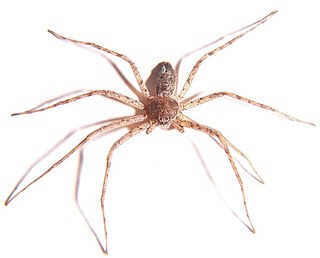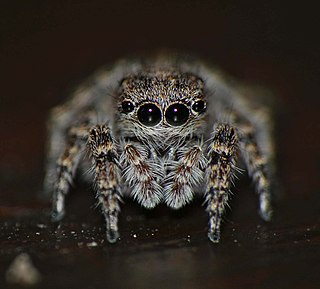
The Thomisidae are a family of spiders, including about 170 genera and over 2,100 species. The common name crab spider is often linked to species in this family, but is also applied loosely to many other families of spiders. Many members of this family are also known as flower spiders or flower crab spiders.

The hobo spider is a member of the family of spiders known colloquially as funnel web spiders, but not to be confused with the Australian funnel-web spider. Individuals construct a funnel-shaped structure of silk sheeting and lie in wait at the small end of the funnel for prey insects to blunder onto their webs. Hobo spiders sometimes build their webs in or around human habitations. The hobo spider lays its eggs in September and they hatch during late spring. After the male hobo spider mates it dies.

Huntsman spiders, members of the family Sparassidae, are known by this name because of their speed and mode of hunting. They are also called giant crab spiders because of their size and appearance. Larger species sometimes are referred to as wood spiders, because of their preference for woody places. In southern Africa the genus Palystes are known as rain spiders or lizard-eating spiders. Commonly, they are confused with baboon spiders from the Mygalomorphae infraorder, which are not closely related.

Latrodectus is a broadly distributed genus of spiders with several species that are commonly known as the true widows. This group is composed of those often loosely called black widow spiders, brown widow spiders, and similar spiders. However, the diversity of species is much greater. A member of the family Theridiidae, this genus contains 34 species, which include several North American "black widows". Besides these, North America also has the red widow Latrodectus bishopi and the brown widow Latrodectus geometricus, which, in addition to North America, has a much wider geographic distribution. Elsewhere, others include the European black widow, the Australian redback spider and the closely related New Zealand katipō, several different species in Southern Africa that can be called button spiders, and the South American black-widow spiders. Species vary widely in size. In most cases, the females are dark-coloured and can be readily identified by reddish markings on the central underside (ventral) abdomen, which are often hourglass-shaped.

Agelenopsis, commonly known as the American grass spiders, is a genus of funnel weavers described by C.G. Giebel in 1869. They weave sheet webs that have a funnel shelter on one edge. The web is not sticky, but these spiders make up for that by running very rapidly. The larger specimens can grow to about 19 mm in body length. They may be recognized by the arrangement of their eight eyes into three rows. The top row has two eyes, the middle row has four eyes, and the bottom row has two eyes. They have two prominent hind spinnerets, somewhat indistinct bands on their legs, and two dark bands running down either side of the cephalothorax.

Philodromidae, also known as philodromid crab spiders and running crab spiders, is a family of araneomorph spiders first described by Tord Tamerlan Teodor Thorell in 1870. It contains over 500 species in thirty genera.

Araneus is a genus of common orb-weaving spiders. It includes about 650 species, among which are the European garden spider and the barn spider. The genus was erected by Carl Alexander Clerck in 1757.

Eresus, also called ladybird spiders, is a genus of velvet spiders that was first described by Charles Athanase Walckenaer in 1805. Members of the genus formerly called Eresus cinnaberinus or Eresus niger are now placed in one of three species: Eresus kollari, Eresus sandaliatus and Eresus moravicus.

Tegenaria parietina is a species of spider native to Europe. Its modern day distribution includes area from Northern Africa to Central Asia and Sri Lanka, and from the West Indies to Uruguay and Argentina, where it may have been introduced. In the UK, it is sometimes known as the cardinal spider, because of the legend that Cardinal Wolsey was terrified by this species at Hampton Court, or, conversely, because he regarded them as lucky and forbade anyone to harm them. In 2013, Tegenaria taprobanica was included in this species.

Titanoeca quadriguttata is a species of spider in the family Titanoecidae. It is widespread in Europe, though absent from Great Britain, and is found in Austria, Belgium, Bulgaria, Corsica, Croatia, Czech Republic, France, Germany, Greece, Hungary, Italy, Liechtenstein, Moldova, Russia, Slovakia, Spain, Switzerland, the Netherlands, Ukraine.

Tetragnatha extensa is a species of spider found across the Northern Hemisphere. It has an elongate body, up to 11 mm (0.43 in) long, and adopts a straight line posture when alarmed. It lives on low vegetation in damp areas, and feeds on flying insects which it catches in its web.

Heliophanus cupreus, the copper sun jumper, is a species of jumping spider belonging to the family Salticidae.

Philodromus aureolus, the wandering crab spider, is a mainly European running crab spider of the family Philodromidae. The taxonomy of the species group named after Philodromus aureolus is in a state of flux and a number of new species have recently been recognised.

Langelurillus furcatus is a species of jumping spider in the genus Langelurillus that lives in Kenya and Tanzania. It was first described in 2000 by Wanda Wesołowska and Anthony Russell-Smith. The spider is small, with a carapace that is between 1.8 and 2.4 mm long and an abdomen between 1.7 and 2.7 mm long. The male is smaller than the female. It has a dark brown carapace, although the female is lighter, that has no markings. The female abdomen is dark russet with a pattern of black and white patches and the male abdomen is dark fawn with an indistinct light pattern. It has orange legs with dark patches, the female also having dark rings on its legs. The spider is similar to other related species, particularly Langelurillus alboguttatus, but can be distinguished by its two tibial apophysis, which make a V-shape. The epigyne has a deep depression that is plugged with a waxy secretion.

Langelurillus manifestus is a species of jumping spider in the genus Langelurillus that lives in Tanzania. It was first described in 2000 by Wanda Wesołowska and Anthony Russell-Smith. The spider is small, with a carapace that is between 2.1 and 2.5 mm long and an abdomen between 2.0 and 2.2 mm long. The female carapace is lighter than the male and has a pattern of irregular patches, which may also be found in some examples of the female abdomen. The male abdomen is lighter and has a fawn streak down the middle. The legs are brown, the female having dark rings on its legs. It is similar to other related species, particularly Langelurillus rufus, but can be distinguished by the male's larger size and lighter coloration. The female has an oval epigyne that leads to seminal ducts that are shorter than Langelurillus rufus but longer than Langelurillus squamiger.

Langelurillus ignorabilis is a species of jumping spider in the genus Langelurillus that lives in Zimbabwe. The female was first described in 2008 by Wanda Wesołowska and Meg Cumming based on an example discovered with ten spiderlings. The male has not been identified. The spider is small with a dark brown carapace 2.7 mm (0.11 in) long and a brownish-grey abdomen 3.0 mm (0.12 in) long. It has short yellow legs. The species is similar to others in its genus and also member of the genus Langona, but differs in the design of the copulatory organs. For example, the seminal ducts are longer and have more loops than Langona bethae.

Langelurillus minutus is a species of jumping spider in the genus Langelurillus that lives in Namibia and Zimbabwe. It was first described in 2011 by Wanda Wesołowska and Meg Cumming. The spider is small, with a cephalothorax that is between 1.8 and 2.3 mm long and an abdomen between 1.5 and 3.9 mm long. The male is noticeably smaller than the female, which is reflected in the species name. The species is generally brown, but has indistinct patches on its abdomen and orange or orange-yellow legs. The male has a very convex palpal bulb and the female an epigyne with a large pocket and compact multi-chambered receptacles.

Phintella occidentalis is a species of jumping spider in the subfamily Salticinae that lives in Ivory Coast. First described by Wanda Wesołowska and Anthony Russell-Smith in 2022, the species is named after the Latin word for western as it is found in West Africa. The spider is small, with a cephalothorax between 2.3 and 2.8 mm long and an abdomen that is between 3.1 and 3.5 mm long. The female is smaller than the male. The carapace is brown, the female light and the male dark. The abdomen is yellow and is marked by two wide brown stripes on the female and a grey streak on the male. It is the abdominal pattern that most clearly distinguishes the species from others in the genus. The copulatory organs are also different. The male has a longer tibial apophysis, or appendage and the female has seminal ducts that diverge and then converge.

Phintella globosa is a species of jumping spider in the genus Phintella that lives in Ivory Coast. First described by Wanda Wesołowska and Anthony Russell-Smith in 2022, the spider is small, with a cephalothorax typically 2.1 mm (0.083 in) long and an abdomen 2.0 mm (0.079 in) long. Only the female has been described. The carapace is dark brown and the abdomen yellow. Although similar to the related Phintella lucida, the copulatory organs are distinctive. The spermathecae are particularly large and spherical, which is recalled in the species name.

Phintella transversa is a species of jumping spider in the genus Phintella that lives in Ivory Coast. First described by Wanda Wesołowska and Anthony Russell-Smith in 2022, only the male has been identified. The spider is small, with a cephalothorax between 2.0 and 2.4 mm long and an abdomen that is between 2.1 and 2.4 mm long. The carapace is dark brown and the abdomen is brownish-black and marked with four light, nearly white streaks. It is that abdominal pattern that most clearly distinguishes the species from others in the genus and is recalled in the species name. The copulatory organs are also distinctive. The palpal bulb has a small triangular lobe on the back and a curved addition near the small embolus.

















